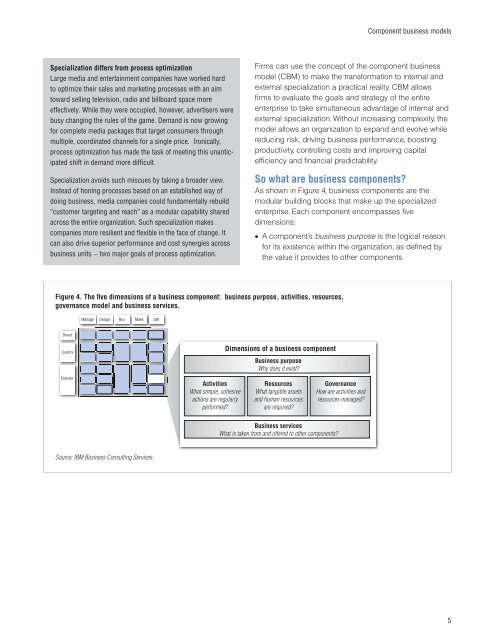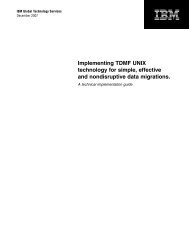Component business models - IBM
Component business models - IBM
Component business models - IBM
Create successful ePaper yourself
Turn your PDF publications into a flip-book with our unique Google optimized e-Paper software.
Specialization differs from process optimization<br />
Large media and entertainment companies have worked hard<br />
to optimize their sales and marketing processes with an aim<br />
toward selling television, radio and billboard space more<br />
effectively. While they were occupied, however, advertisers were<br />
busy changing the rules of the game. Demand is now growing<br />
for complete media packages that target consumers through<br />
multiple, coordinated channels for a single price. Ironically,<br />
process optimization has made the task of meeting this unanticipated<br />
shift in demand more difficult.<br />
Specialization avoids such miscues by taking a broader view.<br />
Instead of honing processes based on an established way of<br />
doing <strong>business</strong>, media companies could fundamentally rebuild<br />
“customer targeting and reach” as a modular capability shared<br />
across the entire organization. Such specialization makes<br />
companies more resilient and flexible in the face of change. It<br />
can also drive superior performance and cost synergies across<br />
<strong>business</strong> units – two major goals of process optimization.<br />
Figure 4. The fi ve dimensions of a <strong>business</strong> component: <strong>business</strong> purpose, activities, resources,<br />
governance model and <strong>business</strong> services.<br />
Direct<br />
Control<br />
Execute<br />
Manage Design Buy Make Sell<br />
Source: <strong>IBM</strong> Business Consulting Services.<br />
Activities<br />
What simple, cohesive<br />
actions are regularly<br />
performed?<br />
<strong>Component</strong> <strong>business</strong> <strong>models</strong><br />
Firms can use the concept of the component <strong>business</strong><br />
model (CBM) to make the transformation to internal and<br />
external specialization a practical reality. CBM allows<br />
firms to evaluate the goals and strategy of the entire<br />
enterprise to take simultaneous advantage of internal and<br />
external specialization. Without increasing complexity, the<br />
model allows an organization to expand and evolve while<br />
reducing risk, driving <strong>business</strong> performance, boosting<br />
productivity, controlling costs and improving capital<br />
efficiency and financial predictability.<br />
So what are <strong>business</strong> components?<br />
As shown in Figure 4, <strong>business</strong> components are the<br />
modular building blocks that make up the specialized<br />
enterprise. Each component encompasses five<br />
dimensions:<br />
• A component’s <strong>business</strong> purpose is the logical reason<br />
for its existence within the organization, as defined by<br />
the value it provides to other components.<br />
Dimensions of a <strong>business</strong> component<br />
Business purpose<br />
Why does it exist?<br />
Resources<br />
What tangible assets<br />
and human resources<br />
are required?<br />
Business services<br />
What is taken from and offered to other components?<br />
Governance<br />
How are activities and<br />
resources managed?<br />
5

















